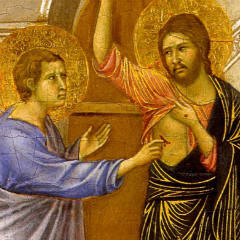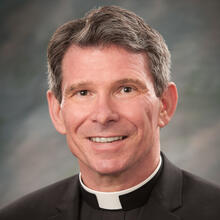We label most everything. Assigning a verbal tag is an essential part of modern life. Turn on cable news, and you’re likely to read: “Breaking News, Terror Alert.” It’s probably not actual breaking at that very moment, but such is the effectiveness of labels. To label something is to make it “at hand,” a part of the world that lies under our control, our comprehension.
Labels are verbal short-cuts for thought. Once something has been labeled, it’s been reined in by the one who labels. Unfortunately, it has also been reduced in its own right. Politics has always been about labeling. Consider what’s been accomplished this year alone by labeling another a loser, a choker or a liar.
We call him Doubting Thomas, a very unfair label, especially for someone, so much like ourselves. Thomas simply believes that he understands the way of the world. He grasps, as we like to say, the laws of nature. He knows what can be expected. Maybe we should label him, “Contemporary Thomas.” After all, he doesn’t doubt something reasonable, something scientific, as we like to say. He only doubts the incredible.
But as the Duke Divinity School theologian Norman Wirzba points out in his insightful little book From Nature to Creation (2015), the notion of nature as a passive object, which lies ready to hand for our use, even our exploitation, is a relatively modern. The ancients thought the world to be infused with spirits. These spirits were the explanation for the phenomena, at which our forebears marveled. Spirits, good or bad, caused storms, earthquakes, childbirth and death.
Admittedly, that strikes us as foolish, but at least admit that the ancients stood in awe of the world around them. They found it worthy of their reverence, their respect. The earth wasn’t simply theirs for the taking.
Contrast their approach with our own. Once we label a plant a weed, its fate is decided. Once we determine the “inner laws” of nature, we use them to redirect, and sometimes to undermine, what we ourselves call “the natural order.”
Now we have reason to fear what we have wrought, approaching the world as “nature,” as nothing more than the object of our desires, our comprehension. In reducing the earth, our very human world, to nature we have threatened it and ourselves. Now we hope that making earth a mother, garlanding a tree, will solve our problems.
Those who exploit always label. It’s part of the process, realized or not. Given the modern conception of motherhood, as something undertaken only by personal preference and otherwise tightly controlled through contraception, do we truly reverence the earth and her bounty by labeling her “Mother Nature?” Hasn’t “motherhood” long since become one more reality that we control?
In asking Thomas to touch his wounded flesh, Christ reveals creation itself to the saint. He reveals a restored and renewed world, one which has come forth from God, a world, which corresponds to our reason because it was created by the highest intelligence. Christ reveals a world which, because it comes forth from spirit, remains, even in its most physical manifestations, oriented toward spirit. Christ makes known a world which came from love and which will yet be redeemed by love.
Thomas wasn’t a doubter. He was simply one of the shallow ones, who think that reality is reducible to what they understand. The resurrection of Christ reveals a world still full of wonder and possibility, because the earth comes forth from spirit and returns to spirit.
Wirzba quotes the poet William Blake to great effect:
If the doors of perception were cleansed, everything would appear to man as it is: infinite. For man has closed himself up, till he sees all things thro’ narrow chinks of his cavern.
We’re the ones who chose to make the world into a cavern of our small consciousness, but we can also decide to open our eyes and hearts and to say with Thomas, “My Lord and my God” (Jn 20:28).
The Fourth Gospel is full of signs. Events, gestures and objects, which must be pondered if they are to reveal their inner meaning. It is the same in the liturgy, where the resurrection is both proclaimed and realized. It’s here that earthen things like water and oil and smoke are given new, transcendent meaning, spirit infused significance. In the Eucharist, bread and wine break through past and future to become the Body and the Blood of the Risen Lord.
The shallow think that the purpose of liturgy is education, encouragement. They make of it one more human tool, reducing it to an ecclesial pep rally, always looking for something novel to exploit. But it is in the liturgy that the material world is honored as creation rather than exploited as nature. In the liturgy, in its quiet motions and graceful gestures, that we slip from the caverns of our consciousness.
We foolishly think that Thomas was overwhelmed by proof, but nothing that is worthy of, that calls to, the human spirit is made evident to us by proof: not love, not beauty, not a truth large enough in which to live.
There are essentially two choices, two ways of living in the world. Labeling everything in our purview to make it ours, or sensing within, and beneath, the material world, a spirit, a presence, that is not ourselves, from which we come, by which we are redeemed, even from our ways of thought.
Acts 5: 12-16 Revelation 1: 9-11a, 12-13, 17-19 John 20: 19-31








